20 year Data Centre Financial Model
This 20-Year, 3-Statement Excel Data Centre Financial Model includes revenue streams from Colocation to Managed Services, cost structures, and financial statements to forecast the financial health of your Data Centre. User Guide.
Financial Model for a 20 Year Data Centre
This very extensive 20 Year Data Centre Model involves detailed revenue projections, cost structures, capital expenditures, and financing needs. (5 Year Model) This model provides a thorough understanding of the financial viability, profitability, and cash flow position of the centre. Including: 20x Income Statements, Cash Flow Statements, Balance Sheets, CAPEX sheets, OPEX Sheets, Statement Summary Sheets, and Revenue Forecasting Charts with the specified revenue streams, BEA charts, sales summary charts, employee salary tabs and expenses sheets. Over 160 Tabs of financial data to monitor.
Income Statement (Profit & Loss Statement)
The Income Statement outlines the revenues, costs, and profitability of the data centre.
Revenue Streams:
Revenue is derived from multiple sources, categorized into the 6-Tier Subscription:
Colocation Services
- Rack space rental (per rack, per square foot)
- Power consumption charges
- Network bandwidth fees
- Cross-connect charges
- SLA-based premium support
Cloud Services
- Public, private, and hybrid cloud offerings
- Compute resources (CPU, RAM)
- Storage (block, object, file)
- Network traffic and security services
Managed Services
- IT infrastructure management
- Monitoring, security, patching, and compliance
- Remote hands and on-site support
Dedicated Hosting
- Bare-metal servers rental
- Custom configurations and managed hardware
Backup & Recovery
- Data backup services
- Disaster recovery as a service (DRaaS)
Content Delivery Network (CDN)
- Edge caching and acceleration services
- Bandwidth-based pricing
Operating Expenses (OPEX):
- Power & Cooling Costs (Energy expenses are a significant cost)
- Network & Connectivity Costs (Internet, peering, transit)
- Maintenance & Repairs (Data centre equipment servicing)
- Salaries & Wages (Technical, sales, and support staff)
- Software & Licensing Fees (Virtualization, cloud management)
- Marketing & Sales Expenses (Customer acquisition, lead generation)
- Security & Compliance Costs (Cybersecurity, certifications)
- Depreciation & Amortization (IT assets, buildings, and infrastructure)
Profitability Metrics:
- Gross Profit = Revenue – Direct Costs (Power, Connectivity, Maintenance)
- EBITDA = Gross Profit – Operating Expenses
- Net Profit = EBITDA – Depreciation – Interest – Taxes
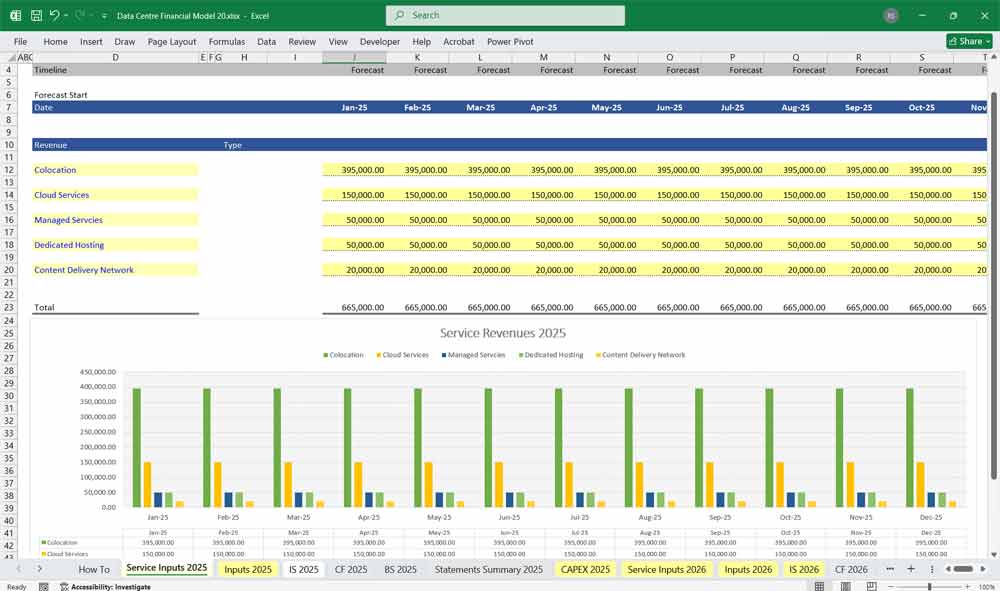
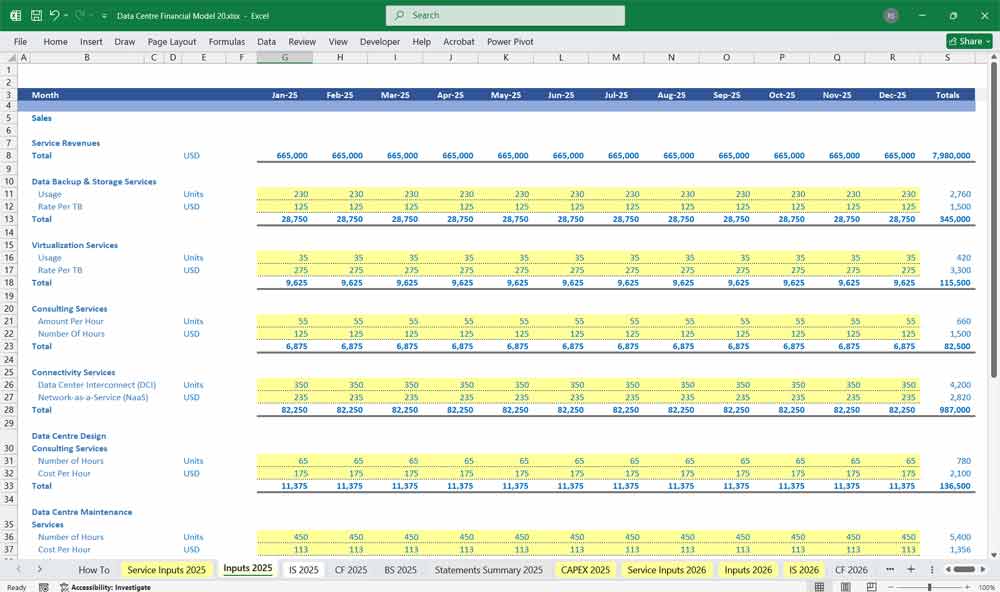
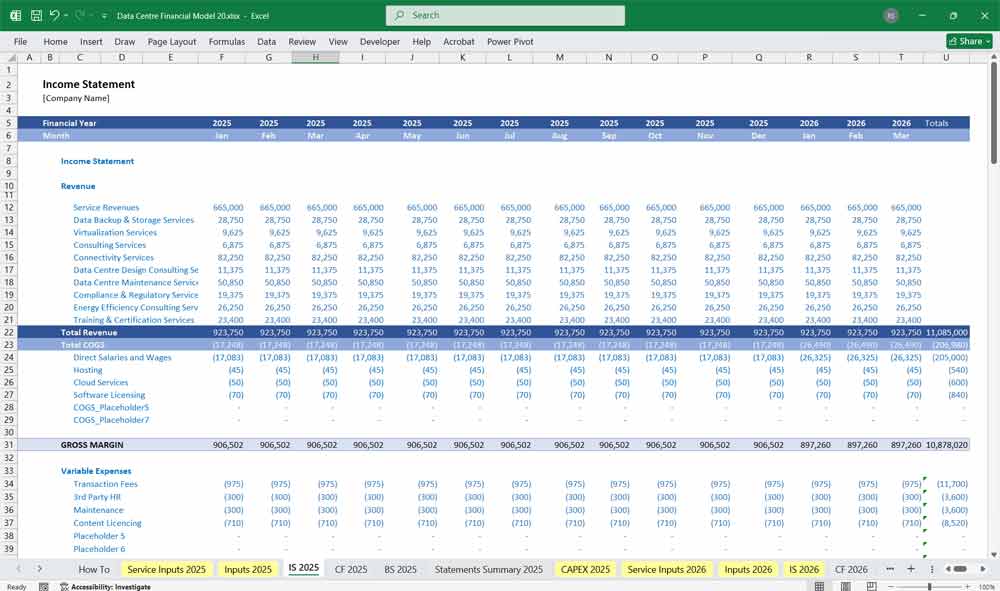
Data Centre Cash Flow Statement
A Cash Flow Statement tracks cash inflows and outflows across three sections:
Operating Cash Flow:
- Cash receipts from customers (subscription revenues)
- Payment of operating expenses (power, rent, salaries)
- Net working capital changes (receivables, payables)
Investing Cash Flow:
- Purchase of new servers, storage, network equipment
- Expansion or upgrade of data centre facilities
- Investments in software, automation, security systems
Financing Cash Flow:
- Debt financing (loans for infrastructure expansion)
- Equity funding (new investments from stakeholders)
- Interest and loan repayments
- Dividend payments (if applicable)
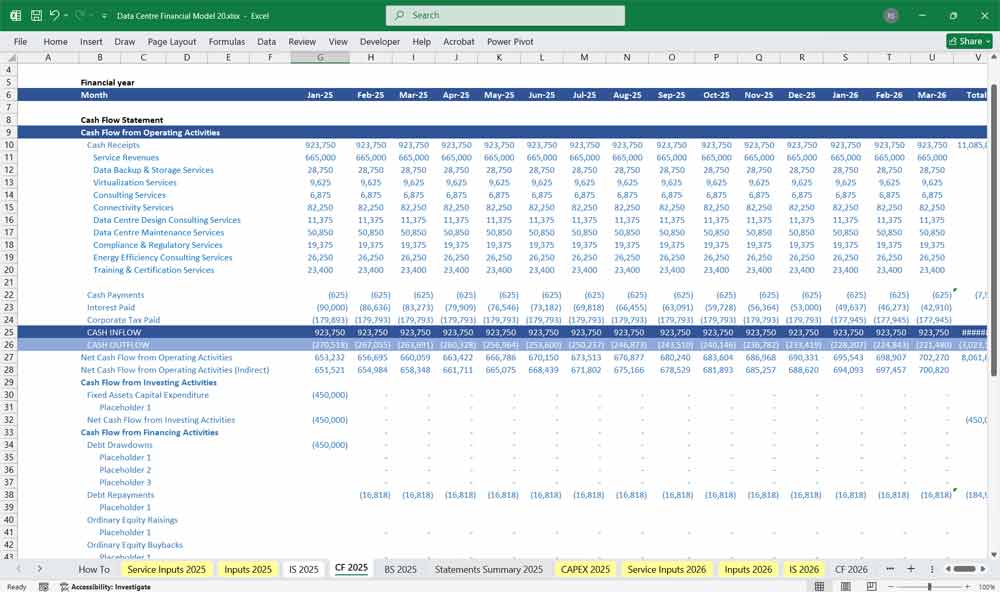
Data Centre Balance Sheet
The Balance Sheet for a 20 Year Data Centre Financial Model
provides a snapshot of the data centre’s financial position.
Assets:
Current Assets
- Cash and cash equivalents
- Accounts receivable (outstanding customer payments)
- Inventory (spare parts, hardware stock)
Fixed Assets
- Data centre infrastructure (racks, cooling, power backup)
- IT equipment (servers, storage, networking)
- Real estate and leasehold improvements
Intangible Assets
- Software, licenses, and cloud management tools
Liabilities:
Current Liabilities
- Accounts payable (supplier payments due)
- Short-term loans
- Deferred revenue (prepaid subscriptions)
Long-Term Liabilities
- Bank loans and bonds
- Lease obligations
Equity:
- Retained earnings (accumulated profits)
- Shareholder capital (investor equity)
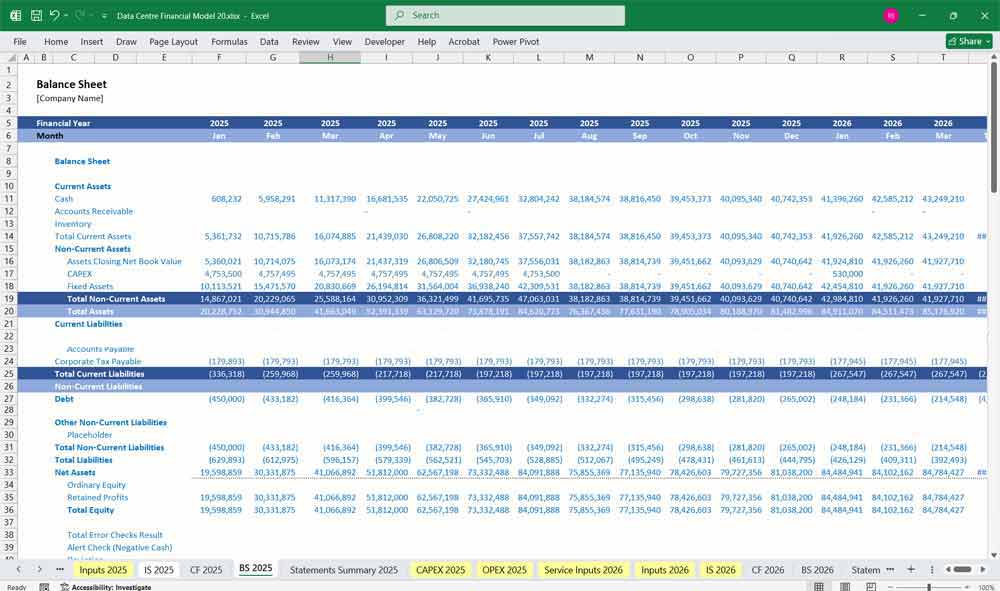
Key Financial Metrics for a Data Centre
Revenue Metrics
Monthly Recurring Revenue (MRR): Predictable income from ongoing services like colocation, cloud hosting, or managed services.
Annual Recurring Revenue (ARR): Yearly equivalent of MRR, providing a long-term revenue outlook.
Revenue per Rack: Average income generated per server rack, indicating space utilization efficiency.
Revenue per Square Foot: Income generated per unit of physical space, reflecting facility efficiency.
Cost Metrics
Capital Expenditure (CapEx): Initial investment in infrastructure, hardware, and construction.
Operational Expenditure (OpEx): Ongoing costs for maintenance, utilities, staffing, and software.
Cost per Rack: Total cost of operating a single server rack, including power, cooling, and maintenance.
Power Usage Effectiveness (PUE): Ratio of total energy used to energy delivered to IT equipment (lower PUE = better efficiency).
Benefits of Using a Data Centre Financial Model
Data Centre: Cost Optimization
- Identifies areas to reduce operational expenses
- Forecasts CAPEX and OPEX for better budgeting
- Optimizes resource allocation for maximum ROI
Data Centre: Revenue Forecasting
- Projects future income based on market trends
- Assesses profitability of different pricing models
- Helps in setting competitive service rates
Data Centre: Investment Planning
- Provides clear ROI projections for stakeholders
- Identifies break-even points for capital investments
- Supports funding decisions and financial backing
Data Centre: Risk Management
- Analyzes potential financial risks and mitigations
- Models impact of market fluctuations on revenue
- Prepares contingency plans for economic downturns
Data Centre: Scalability Planning
- Projects when and how to expand infrastructure
- Balances demand growth with financial feasibility
- Ensures sustainable long-term investment
Data Centre: Pricing Strategy Development
- Helps set competitive pricing for services
- Identifies optimal profit margins
- Adapts pricing to different customer segments
Data Centre: Capital Expenditure Planning
- Determines necessary investments in hardware and facilities
- Allocates budget efficiently for expansion projects
- Evaluates lease vs. purchase options for infrastructure
Data Centre: Operational Expense Management
- Tracks recurring costs like power and cooling
- Identifies cost-saving opportunities in maintenance
- Benchmarks expenses against industry standards
Data Centre: Profitability Analysis
- Measures financial performance against industry peers
- Breaks down profit drivers and cost leakages
- Evaluates long-term sustainability of operations
Data Centre: Financial Compliance & Reporting
- Ensures adherence to accounting and tax regulations
- Generates reports for auditors and stakeholders
- Helps maintain transparency in financial operations
Data Centre: ROI Calculation for Clients
- Demonstrates cost savings for potential customers
- Justifies pricing based on value-added services
- Helps clients make informed purchasing decisions
Data Centre: Funding & Loan Justification
- Provides financial projections for lenders and investors
- Strengthens business cases for loan approvals
- Supports negotiations for better interest rates
Data Centre: Scenario Planning & Sensitivity Analysis
- Models best and worst-case financial situations
- Helps assess impact of economic downturns
- Improves strategic decision-making for resilience
Data Centre: Energy Cost Forecasting
- Estimates power consumption and related expenses
- Identifies efficiency improvements to lower costs
- Helps negotiate better utility contracts
Data Centre: Capacity Planning
- Forecasts infrastructure requirements based on demand
- Balances workload distribution for optimal efficiency
- Prevents over-investment or under-utilization of assets
Data Centre: Competitive Benchmarking
- Compares financial performance with industry leaders
- Identifies cost advantages and efficiency gaps
- Helps refine business strategies for market leadership
Data Centre: Contract & SLA Profitability Analysis
- Evaluates revenue impact of service-level agreements
- Assesses profitability of long-term contracts
- Helps negotiate favorable terms with clients
Data Centre: Hybrid Cloud Cost Comparison
- Assesses cost differences between cloud and on-prem solutions
- Determines when to shift workloads for financial benefit
- Optimizes cloud spending for better cost efficiency
Data Centre: Mergers & Acquisitions Valuation
- Helps determine fair market value for acquisitions
- Assesses financial synergies in potential mergers
- Supports due diligence and investment decisions
Data Centre: Investor Confidence & Stakeholder Engagement
- Provides clear financial insights for investor trust
- Strengthens business credibility with data-backed projections
- Enhances decision-making for board members and executives
Pricing Strategy
Volume Discounts: Discounts for higher usage or long-term commitments.
Add-Ons: Optional add-ons like additional bandwidth, storage, or managed services.
Tier Upgrades: Allow customers to upgrade tiers as their needs grow.
This 6-tier subscription model ensures that the data center can serve a diverse customer base while maximizing revenue opportunities and providing tailored solutions for each segment.
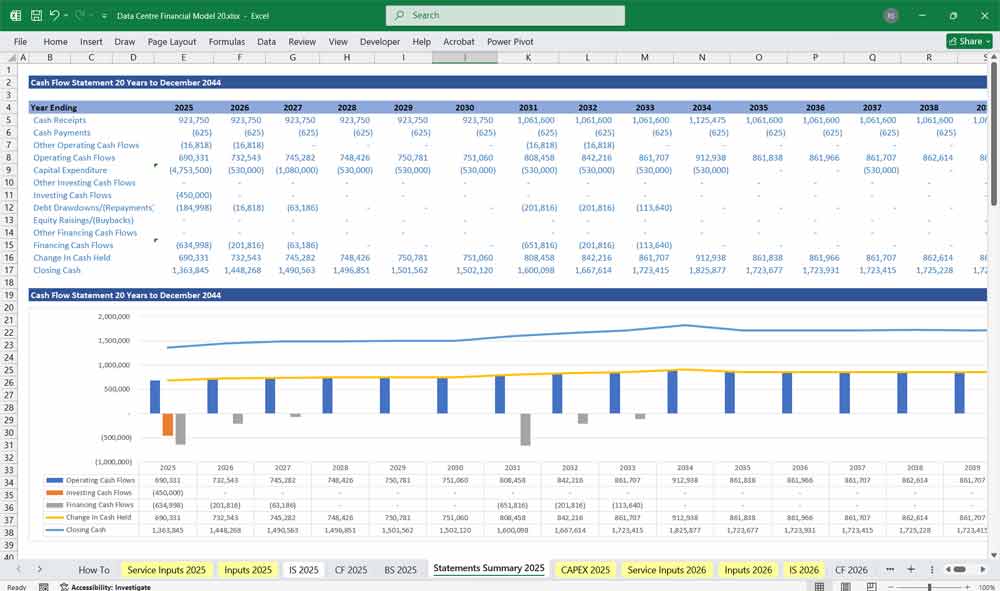
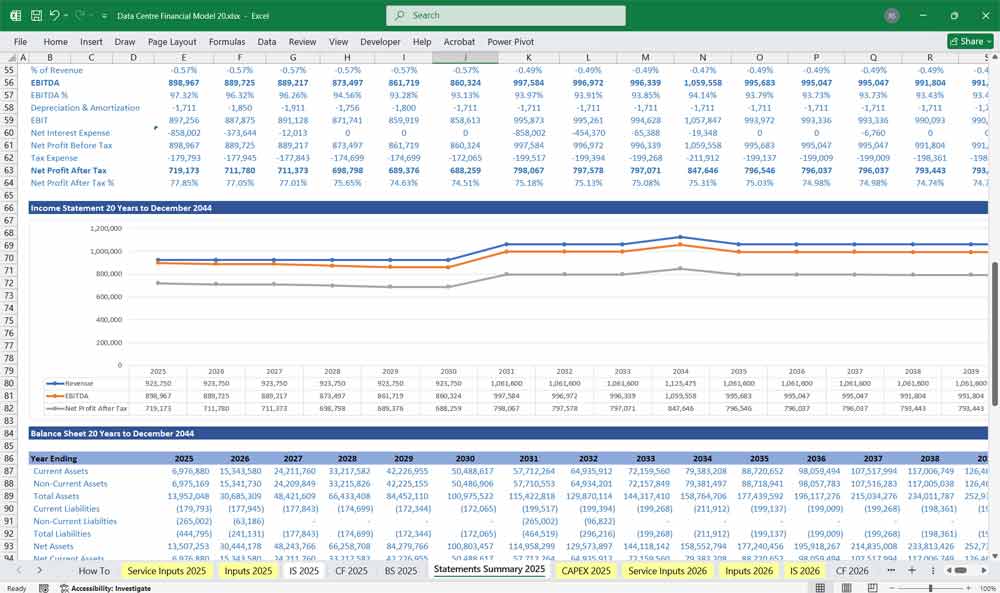
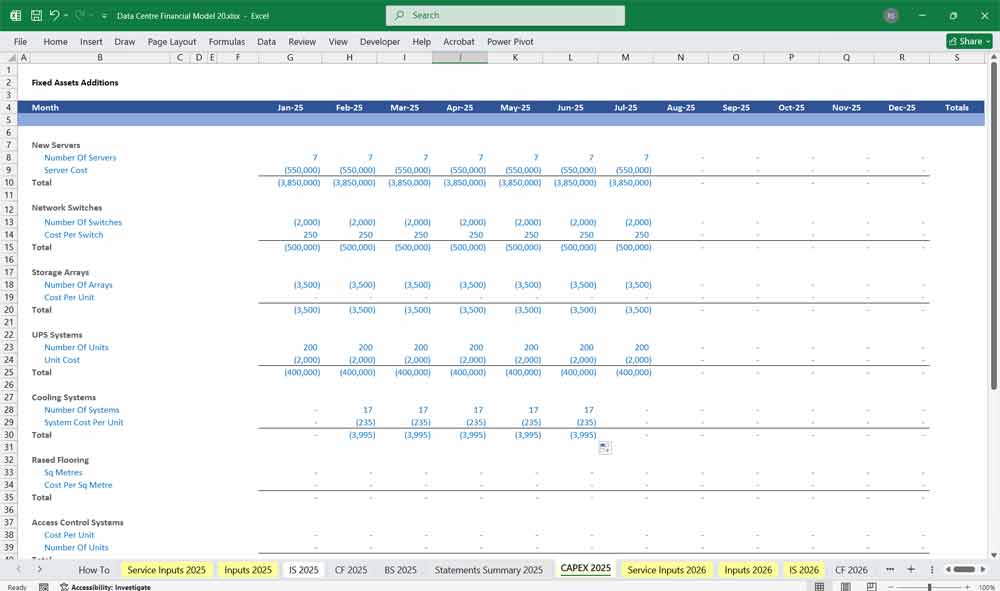
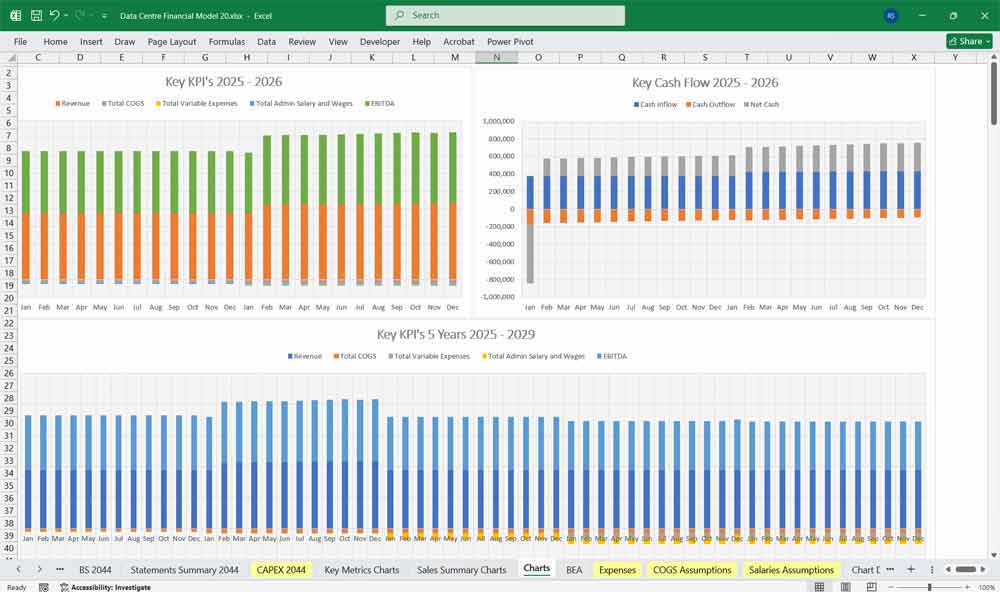
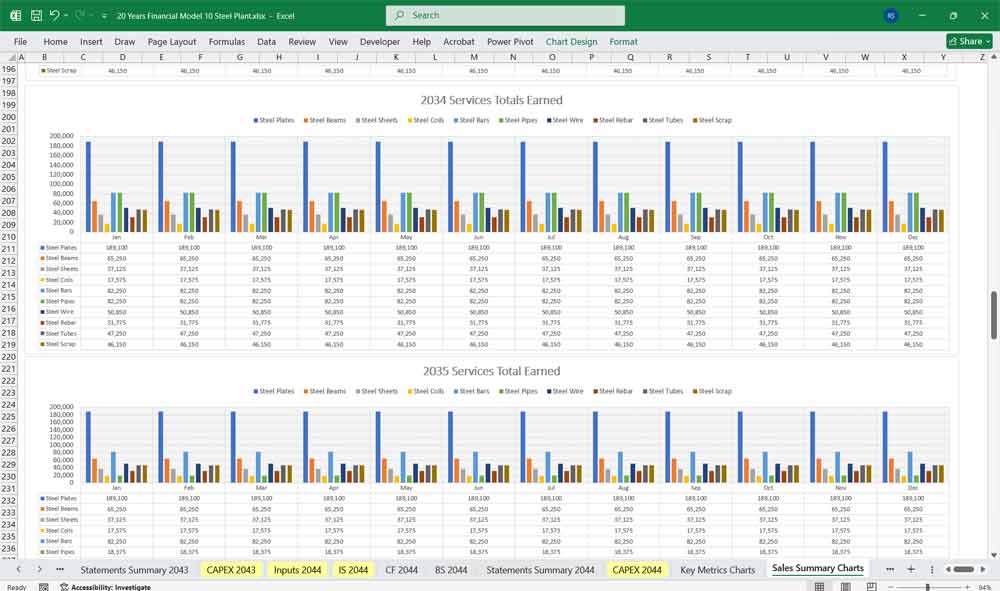
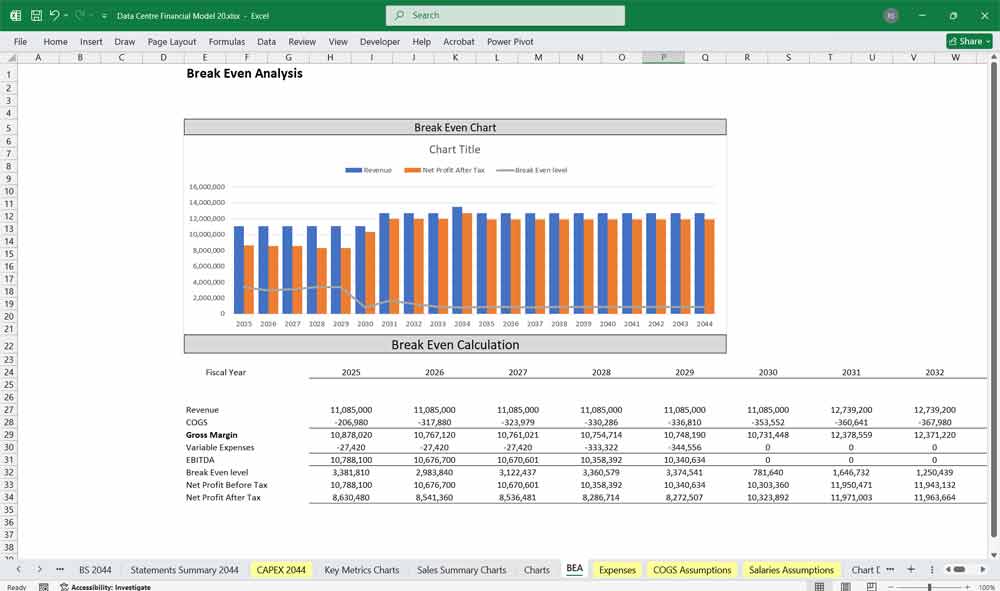
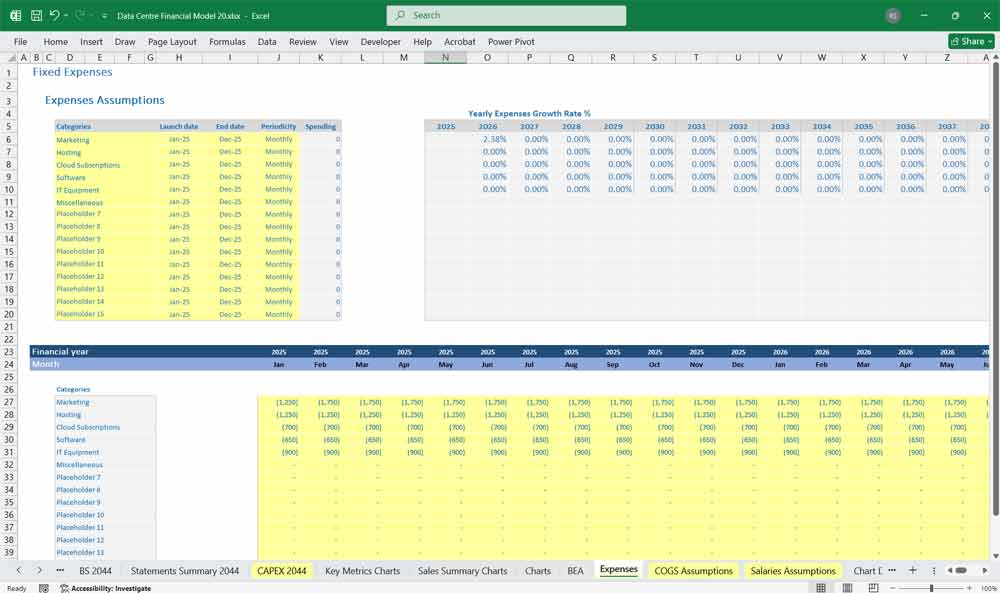
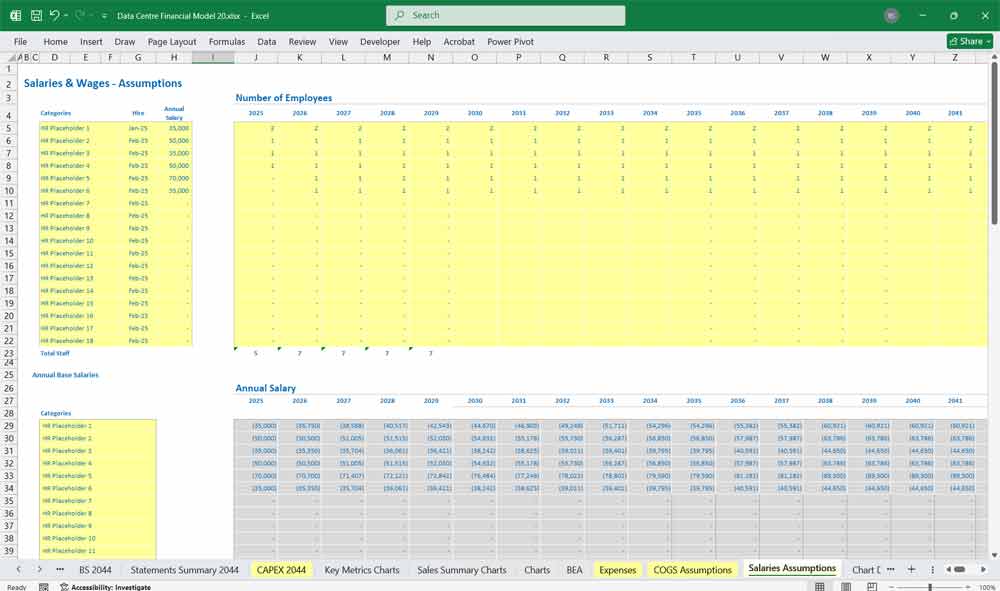
Final Notes on the Financial Model
This 20 Year Data Centre Financial Model must focus on balancing capital expenditures with steady revenue growth from diversified subscription-based services. By optimizing operational costs, and power efficiency, and maximizing high-margin services like cloud and managed offerings, the model ensures sustainable profitability and cash flow stability.
Download Link On Next Page
